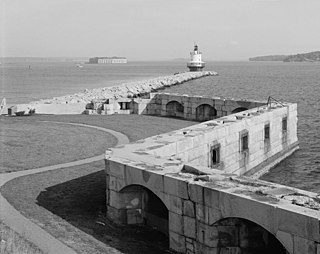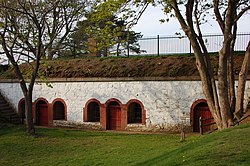
Fort William and Mary was a colonial fortification in Britain's worldwide system of defenses, defended by soldiers of the Province of New Hampshire who reported directly to the royal governor. The fort, originally known as "The Castle," was situated on the island of New Castle, New Hampshire, at the mouth of the Piscataqua River estuary. It was renamed Fort William and Mary circa 1692, after the accession of the monarchs William III and Mary II to the British throne. It was captured by Patriot forces, recaptured, and later abandoned by the British in the Revolutionary War. The fort was renamed Fort Constitution in 1808 following rebuilding. The fort was further rebuilt and expanded through 1899 and served actively through World War II.

Fort Henry National Historic Site is located in Kingston, Ontario, Canada on Point Henry, a strategic, elevated point near the mouth of the Cataraqui River where it flows into the St. Lawrence River at the east end of Lake Ontario. The fort and the point on which the fort was built were named after Henry Hamilton, former Lieutenant-Governor of the Province of Quebec.

Fort Moultrie is a series of fortifications on Sullivan's Island, South Carolina, built to protect the city of Charleston, South Carolina. The first fort, formerly named Fort Sullivan, built of palmetto logs, inspired the flag and nickname of South Carolina, as "The Palmetto State". The fort was renamed for the U.S. patriot commander in the Battle of Sullivan's Island, General William Moultrie. During British occupation, in 1780–1782, the fort was known as Fort Arbuthnot.

Fort McClary is a former defensive fortification of the United States military located along the southern coast at Kittery Point, Maine at the mouth of the Piscataqua River. It was used throughout the 19th century to protect approaches to the harbor of Portsmouth, New Hampshire and the Portsmouth Naval Shipyard in Kittery. The property and its surviving structures are now owned and operated by the State of Maine as Fort McClary State Historic Site, including a blockhouse dating from 1844.

Fort Adams is a former United States Army post in Newport, Rhode Island that was established on July 4, 1799 as a First System coastal fortification, named for President John Adams who was in office at the time. Its first commander was Captain John Henry who was later instrumental in starting the War of 1812. The current Fort Adams was built 1824–57 under the Third System of coastal forts; it is part of Fort Adams State Park today.

Fort Preble was a military fort in South Portland, Maine, United States, built in 1808 and progressively added to through 1906. The fort was active during all major wars from the War of 1812 through World War II. The fort was deactivated in 1950. It is now on the campus of Southern Maine Community College.

Fort Washington, located near the community of Fort Washington, Maryland, was for many decades the only defensive fort protecting Washington, D.C. The original fort, overlooking the Potomac River, was completed in 1809, and was begun as Fort Warburton, but renamed in 1808. During the War of 1812, the fort was destroyed by its own garrison during a British advance.

Fort Popham is a Civil War-era coastal defense fortification at the mouth of the Kennebec River in Phippsburg, Maine. It is located in sight of the short-lived Popham Colony and, like the colony, named for George Popham, the colony's leader. The site is preserved as Fort Popham State Historic Site.

Fort Pickering is a 17th-century historic fort site on Winter Island in Salem, Massachusetts. Fort Pickering operated as a strategic coastal defense and military barracks for Salem Harbor during a variety of periods, serving as a fortification from the Anglo-Dutch Wars through World War II. Construction of the original fort began in 1643 and it saw use as a military installation into the 20th century. Fort Miller in Marblehead also defended Salem's harbor from the 1630s through the American Civil War. Fort Pickering is a First System fortification named for Colonel Timothy Pickering, born in Salem, adjutant general of the Continental Army and secretary of war in 1795. Today, the remains of the fort are open to the public as part of the Winter Island Maritime Park, operated by the City of Salem.

Fort Revere is an 8-acre (3.2 ha) historic site situated on a small peninsula located in Hull, Massachusetts. It is situated on Telegraph Hill in Hull Village and contains the remains of two seacoast fortifications, one from the American Revolution and one that served 1898–1947. There are also a water tower with an observation deck, a military history museum and picnic facilities. It is operated as Fort Revere Park by the Metropolitan Park System of Greater Boston.
Fort Glover was a fort in Marblehead, Massachusetts. Fortifications on the site existed during the American Revolutionary War, the War of 1812, the Civil War, and the Spanish–American War. The fort was located on what is now Riverhead Beach on Bubier Road in Marblehead, sited to guard the beach and the Marblehead Neck causeway. It was demolished in 1917.

Fort Defiance was a fort that existed from 1794 to after 1865 on Fort Point in Gloucester, Massachusetts. The location protecting the inner harbor was also called Watch House Point.
Fort Philip was a fort built in 1776 during the American Revolutionary War and rebuilt in 1808, which also served in the War of 1812 to around 1815. It was in Newburyport, Massachusetts on the northern end of Plum Island, known as Lighthouse Point, guarding the mouth of the Merrimack River. The 1808 rebuilding was part of the second system of US fortifications. The secretary of war's report on fortifications in December 1808 states that "...a battery of wood, filled in with sand and surmounted with sod, has been erected. It... was constructed of wood on account of the shifting sands." A subsequent report in December 1811 describes the fort as "...an enclosed battery, built of earth and timber, mounting five heavy guns... ." The site eventually washed away in the 1830s. A militia artillery battery was stationed in the area in the Spanish–American War.

Fort Nelson was a fort located on Hospital Point in Portsmouth, Virginia, which is currently the site of the Portsmouth Naval Hospital. The fort was named for Thomas Nelson Jr., governor of Virginia in 1781. It and Fort Norfolk were built to guard the Elizabeth River, including the cities of Norfolk and Portsmouth and the Gosport Navy Yard. The fort was originally built by patriot forces with funding from the Virginia government in 1776 during the American Revolutionary War, but destroyed when the British occupied the area in 1779. A British map shows that they rebuilt the fort by 1781. Following the Revolution, the fort was again rebuilt in 1794 under the first system of US fortifications, was garrisoned in the War of 1812, but was demolished in 1827 to make room for the naval hospital. The fort was again rebuilt by Confederate forces in 1861, but the Confederates evacuated the area in May 1862 and the fort was eventually demolished.
Fort Sumner was a coastal defense fortification on Munjoy Hill in Portland, Maine, United States. It was built in 1794 as part of the first system of coastal fortifications built by the United States. It was reportedly originally named Fort Allen after the nearby Revolutionary War battery that probably became part of Fort Sumner, but was renamed in 1797 after Increase Sumner, the incumbent Governor of Massachusetts, of which Maine was then a part. The location is now Fort Sumner Park, also called Standpipe Park, at 60 North Street.
Fort Miller was a coastal defense fort in Marblehead, Massachusetts, in existence circa 1630–1900. Circa 1861 it was renamed for James Miller, a colonel in the War of 1812, distinguished for his actions in the Battle of Lundy's Lane. He was later Collector of the Port in nearby Salem from 1824 to 1849.

The Harbor Defenses of New Bedford was a United States Army Coast Artillery Corps harbor defense command. It coordinated the coast defenses of New Bedford, Massachusetts and the nearby Cape Cod Canal from 1900 to 1950, beginning with the Endicott program. These included a coast artillery fort and an underwater minefield. The command originated circa 1900 as the New Bedford Artillery District, was renamed Coast Defenses of New Bedford in 1913, and again renamed Harbor Defenses of New Bedford in 1925.

Fort Powhatan is a former river defense fort located at Windmill Hill near Garysville, Virginia, 2.5 miles (4.0 km) southeast of Flowerdew Hundred Plantation in Prince George County, Virginia. The fort was named for the area's Powhatan tribe of indigenous people; the name is also an English term for their leader. It is on the south bank of the James River, sited to prevent enemy vessels proceeding upriver to Richmond. The first fort on the site was a two-gun battery called Hood's Battery, built in 1779 during the American Revolutionary War and named after the owner of the plantation it was on. In January 1781, British forces under Benedict Arnold attacked and dismantled the battery and went on to burn Richmond. Later that year a larger fort was built, named Fort Hood. In 1808 this was replaced by the federal government with Fort Powhatan, part of what was later called the second system of US fortifications. The fort was not attacked in the War of 1812. In 1862, during the American Civil War, Confederate forces added a new earthwork battery on the site; the fort area was abandoned by Confederates, and subsequently captured by Union forces in July 1863. The fort was abandoned at the end of the war in 1865.
Fort Greene in Newport, Rhode Island was a small fort built circa 1794 at Battery Park in the Point section of Newport, last active in the War of 1812. It was named for General Nathanael Greene of the Revolutionary War, who was born in Rhode Island. It was built as part of the First System of US seacoast fortifications circa 1794. The location is now Battery Park at Easton's Point, which was sometimes called North Point in the 18th century. It was on the site of a previous battery built in the American Revolution with state resources, called the North Battery. The seawall remains from Fort Greene and is curved at this point.



















